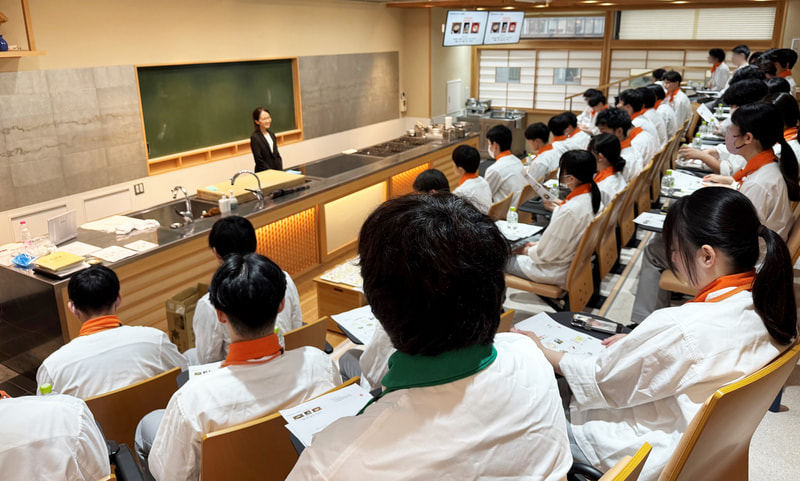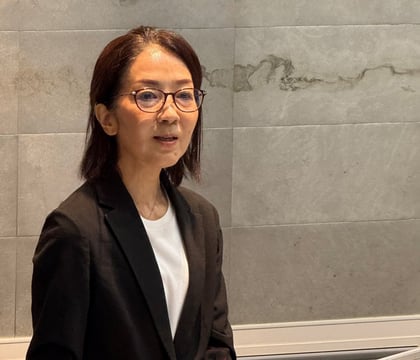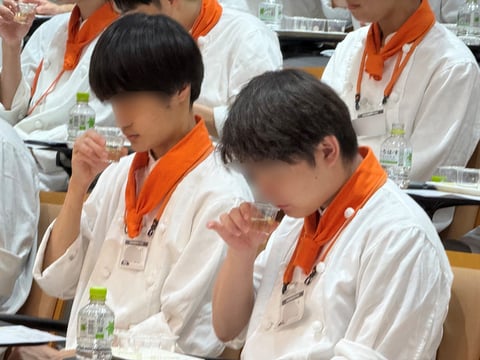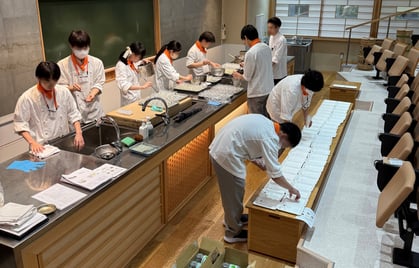Umami Lecture by UIC has started at Shinjuku Institute Culinary College
June 2025

On June 10, 2025, the first special lecture by the Umami Information Center (UIC) titled “Understanding Umami, Sensing Umami” was held at Shinjuku Institute Culinary College. About 40 second-year students and teachers from the school attended the lecture.

“We would like our students to learn about “umami” from the latest culinary scientific perspective. We hope to enrich their learning by providing them with knowledge from both the culture and the science.”
The lecture was realized in response to this request from the college, which offers a wide-ranging curriculum including culinary arts, traditional food culture, and dining manners.
The lecturer was UIC Director Yasue Kido.
In Japanese, umami is a homonym that has two meanings, “umami, one of the basic tastes,” and "deliciousness.” Yasue Kido reminded the students of this situation and explained the elements that determine deliciousness, and the relationship between the basic taste “umami” and deliciousness.
She also introduced the history of the discovery of umami substances and the three characteristics of umami*, using tastings of umami ingredients and several kinds of dashi.
*The three characteristics of umami;
① Spreading across the tongue, ② Persistence, ③ Promotes salivation
In the lecture, the difference between Japanese and Western dashi, the fact that umami substances increase through fermentation, and the umami of Western dishes were also explained.
The students were particularly impressed by the tasting of the synergistic effects of kombu and katsuo dashi. The process for this experience was as follows. Before each step, the mouth should be rinsed with water.
1. Taste the kombu dashi. (experience of tasting the amino acid umami substance “glutamate”)
2. Pour katsuo dashi into a cup of kombu dashi and taste the mixed liquid.
(experience of the umami synergy effect)
3. Taste katsuo dashi alone (experience tasting the nucleotide umami substance “inosinate”)
During the second experience of the synergistic effect, the students' faces lit up and they raised their hands all together when asked, "Did you feel that the umami taste became many times stronger?”
However, it was impressive to see the expressions on their faces change to dubious when they tasted the katsuo dashi alone during the third tasting. When asked how they felt, one of the students replied with a puzzled look on his face, "It's watery....”

Umami is a subtle taste on its own, but when amino acid umami substance and nucleic acid umami substance are combined, umami taste is dramatically enhanced. It becomes seven to eight times or even stronger. It is called the synergistic effect of umami.
In the lecture, Kido also explained the effects of umami on cooking using other tasting experiences, that is, by utilizing umami substances, the tastiness can be maintained even with reduced salt content, and that moderate umami substances enhance the flavor of foods. The students had already learned about umami in the classroom, but they commented that they realized what umami is through this intensive class.

It was the first time for UIC to have a lecture at the Shinjuku Institute Culinary College.
With the cooperation of the college, the dashi was prepared by the teachers. Under the teacher's guidance, the students were also responsible for dispensing dashi and preparing the trays efficiently.
Here is a comment from one of the students.
“I want to become a chef of Western cuisine, and I found out that umami can be applied to Western cuisine. It would give me hints for my future cooking, such as Western dishes using dashi”.
The ability to sense umami is very important for food specialists. This is true regardless of whether the cuisine is Japanese, Western or Chinese.
Because umami, the basic taste, is a sense of taste that is involved with deliciousness and koku in all genres of cuisine around the world.
The knowledge of umami and umami substances can be applied to any cuisine. We hope that this lecture will give the students some hints for their future cooking.
